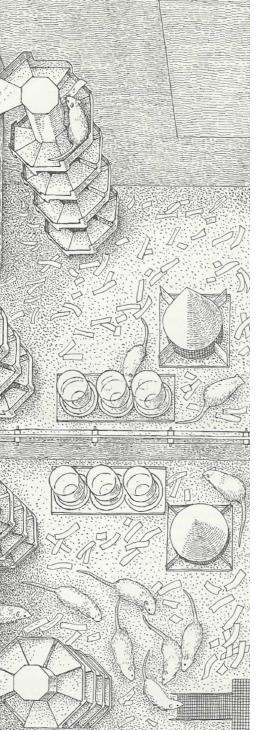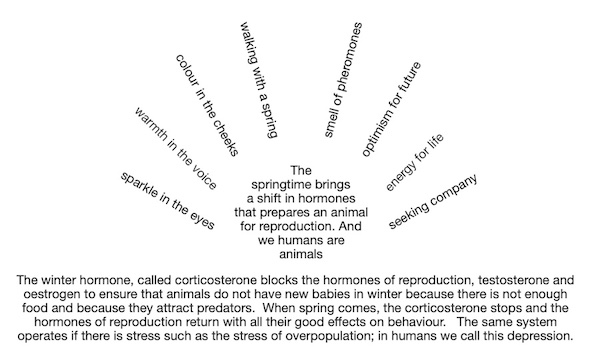Stories
Psychology for Revolutionaries
Psychology for Peace Activists
Why there are so few women warriors
The Seville Statement on Violence
A theory of mental illness
* * *
From the time of my suicide attempts and studies of psychoanalysis and psychology at Columbia College and Yale Graduate School in Psychology, I had thought about how to achieve a scientific understanding of mental illness.
As I took an evolutionary approach to my teaching and research at Wesleyan, I came to see the evolution of mental illness as an interesting puzzle. I presumed that the mechanisms of human mental illness had evolved earlier as an advantageous trait in our animal ancestors.
 Gradually, I found clues to the puzzle. For one thing, there was the phenomenon of "reproductive postponement" that one could see in other mammals, especially in the rodents that were the basic laboratory subject for physiology. Under conditions of overcrowding and food shortage, some animals would stop reproducing and simply "survive" until the next season when they would have a new chance to engage in reproduction. This was described in many field studies of muroid rodents which I read in my work on comparative muroid rodent behavior. It was also described under laboratory and controlled outdoor experiments by a great maverick student of rat behavior, John C. Calhoun, in his monograph that I used for my students, and in a Scientific American article (see illustration at left). In the illustration, some rats are acting in a reproductive mode, males chasing a female in estrus or males guarding a territory. But there are other rats, such as the two in the middle, which Calhoun called "somnambulists" because they had ceased all reproductive activity, It is these "somnambulists" that seem to me models of "mental illness."
Gradually, I found clues to the puzzle. For one thing, there was the phenomenon of "reproductive postponement" that one could see in other mammals, especially in the rodents that were the basic laboratory subject for physiology. Under conditions of overcrowding and food shortage, some animals would stop reproducing and simply "survive" until the next season when they would have a new chance to engage in reproduction. This was described in many field studies of muroid rodents which I read in my work on comparative muroid rodent behavior. It was also described under laboratory and controlled outdoor experiments by a great maverick student of rat behavior, John C. Calhoun, in his monograph that I used for my students, and in a Scientific American article (see illustration at left). In the illustration, some rats are acting in a reproductive mode, males chasing a female in estrus or males guarding a territory. But there are other rats, such as the two in the middle, which Calhoun called "somnambulists" because they had ceased all reproductive activity, It is these "somnambulists" that seem to me models of "mental illness."
At the same time, my students and I found that human depression was characterized by hormone changes very similar to those taking place in rodents during their reproductive postponement: i.e. high levels of corticosterone and depressed levels of the sex hormones such as testosterone and estrogen. In fact, testosterone and estrogen are needed not only for overt sexual and aggressive behavior, but also for nonverbal communication that we take for granted in everyday life, such as color in the face, sparkle in the eyes, vigor in the voice, talkativeness, vigor of movement and posture, etc. A person without these qualities gives the impression of being depressed.
I wrote this as a scientific paper, "Reproductive Postponement and Human Depression." It was presented to the International Pavlov Symposium, Moscow, USSR, 1984. The organizers of the conference did not make good on their promise to publish the paper, but I have put it on my personal website at http://www.culture-of-peace.info/postponement/title-page.html.
Also at that time I compiled a large scientific review of all reproductive systems and reproductive states, but was unable to publish it, and it sits in my files to this day: "Hormonal Influences on Motivational Systems of Social Behavior in Muroid Rodents and Their Significance for Reproductive States".
As far as I know, my analysis of mental illness is still supported by scientific data, and yet it has not yet been published and discussed and used by the medical community. If I did not have so much work to do for a culture of peace, I would be tempted to work on this subject instead, since it could relieve the suffering of so many people and their families.
Many years after writing the above, I made the following poem on the subject that I sent to my friends who were suffering from depession.

 |
Stages
1986-1992
Fall of Soviet Empire
1992-1997
UNESCO Culture of Peace Programme